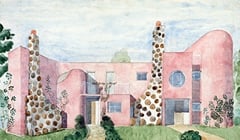Eric Ericson doesn’t allow himself to be pigeonholed. He’s as much an author as a designer, publisher, artist and satirist. But one could also present him as a fan of Estrid Ericson and note that one factor that unites all of his professional roles is his great interest in history.
“Estrid Ericson was an incredible artistic leader. As early as the 1920s, she succeeded in engaging the best designers of the day, such as Nils Fougstedt, Anna Petrus and Uno Åhrén. But at the same time she was open to abandoning functionalism when she met Josef Frank. I’m extremely fascinated by Estrid Ericson and everything she achieved,” says Eric Ericson, who has produced an exhibition about Svenskt Tenn’s founder in her hometown of Hjo and published a book about her through his own publishing company Orosdi-Back.
Swedish design of the 1920s and 30s is a recurring source of inspiration for the designer Eric Ericson; this is reflected not least in the products he has designed for Svenskt Tenn. Take, for example, the theatrical faces engraved on the back of the hand mirrors in the “Självbild” (Self-image) collection, which are produced in pewter and bound leather. Or take Eric’s pewter pots, which the creator says are greatly influenced by the style epoch which he calls Sweden’s most singular: both in terms of form, being square at the base and turning outward at the top, and in the theatrical faces.
Swedish design of the 1920s and 30s is a recurring source of inspiration for the designer Eric Ericson.
Erik’s interest in history has also found expression in the books published by his own company, including books on Josef Frank and Näfveqvarn Bruk, which manufactured items not least designed by Svenskt Tenn’s early designers, such as Anna Petrus and Gunnar Asplund.
“The fact that Orosdi-Back publishes a series of cheap paperbacks is also no coincidence – the idea is inspired by Gregor Paulsson’s early 1900s journal “ Vackrare vardagsvara” (Lovelier weekdays), says Eric.
Eric Ericsson’s breakthrough as an author came in 2003 with the book “Brev till samhället” (Letters to society), in which he writes zany letters to companies and organisations and receives equally zany replies. He has a never ending fascination with social planning and development, which also finds expression in, for example, the parlour game “Välkommen till samhället” (Welcome to society), which is a collaboration with the artist Lars Arrhenius. But Svenskt Tenn has also benefited from it in several contexts.
“I’m interested in why things appear as they do during a certain time and which production processes are used at different times.”
Svenskt Tenn is owned by the Kjell and Märta Beijer foundation, which among other things contributes large research grants to the Beijer Institute. There, research is carried out on the interaction between humans and nature, and when Svenskt Tenn presented the exhibition “Biosphere patterns”, on this theme, four artists (of whom Eric Ericson was one), were each given a poster to interpret the Beijer Institute’s research.
“I’m interested in why things appear as they do during a certain time and which production processes are used at different times. This, in turn, has to do with how society functions,” says Eric.
When we meet, he’s in the process of writing a book about the thousands of Nazis who fled to the Middle East after the Second World War. But as far as design is concerned, he’s happy to stick to Sweden and Svenskt Tenn.
“I want to contribute to things that stand for quality”.









































































